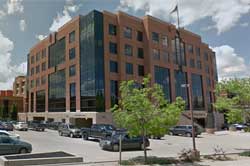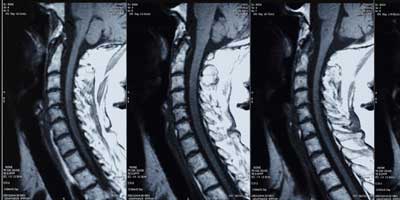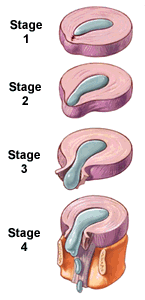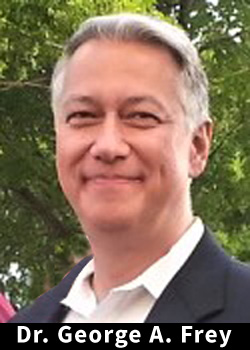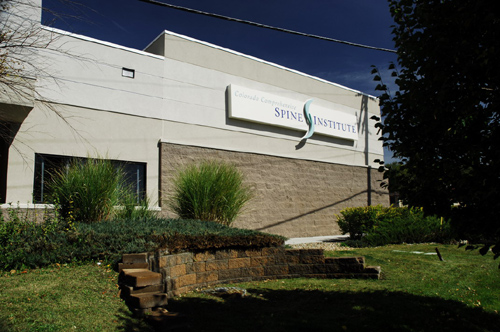Locations

Fax: (303) 762-9292

Explaining Spinal Disorders: Cervical Disc Herniation
Millions of people suffer neck, shoulder, and arm pain. A herniated disc is a common cause of this pain. Intervertebral discs, which act as the spine’s shock absorbers, are located in between each of the spine’s vertebrae. Each disc contains a tire-like outer band (annulus fibrosus) that surrounds a gel-like substance (nucleus pulposus).
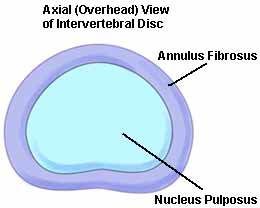 Symptoms
Symptoms
The symptoms of a cervical herniated disc may include:
- Dull or sharp pain in the neck or between the shoulder blades. Pain may be intensified during movement.
- Pain radiating (spreading) down into the arm, hand or fingers. This is called a radiculopathy.
- Numbness or tingling in the shoulder or arm.
How Discs Herniate
If the disc’s outer band cracks or breaks open, the gel inside the disc can leak out causing a herniated disc. The disc material may place pressure on nearby nerve roots or the spinal cord. Additionally nuclear material releases chemical irritants causing nerve inflammation and pain.
Sudden stress such as from an accident can cause a cervical disc to herniate. Sometimes, a disc herniation develops gradually over weeks or months.
Stages of Disc Herniation
1. Disc Degeneration: chemical changes associated with aging causes discs to weaken, but without a herniation.
2. Prolapse: the form or position of the disc changes with some slight impingement into the spinal canal. Also called a bulge or protrusion.
3. Extrusion: the gel-like nucleus pulposus breaks through the tire-like wall (annulus fibrosus) but remains within the disc.
4. Sequestration or Sequestered Disc: the nucleus pulposus breaks through the annulus fibrosus and lies outside the disc in the spinal canal (HNP).
Risk factors that can contribute to disc herniation include:
- Aging. As you get older, discs gradually dry out, affecting disc strength and resiliency.
- History of major or minor cervical spine trauma.
- Lifestyle choices. Lack of regular exercise, eating an unbalanced diet, and tobacco use substantially contributes to poor disc health.
- Poor posture, incorrect and/or repetitive lifting or twisting places additional stress on the cervical spine.
Diagnosis
Our comprehensive diagnostic process includes:
- Medical history. You doctor talks to you about your symptoms, their severity, and what treatments you have already tried.
- Physical examination. You are carefully examined for movement limitations, balance problems, and pain. During your exam, the doctor evaluates loss of extremity reflexes, muscle weakness, loss of sensation, or other signs of a neurological problem.
- Diagnostic tests. Generally, the doctor starts with plain x-ray films, which help rule out other problems such as a tumor or infection. CT scans and MRIs are performed to obtain more detail about your spinal problem.
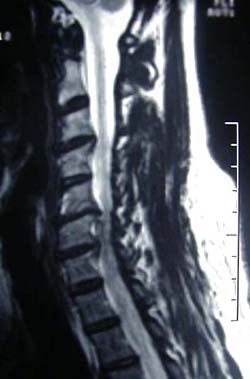
Cervical disc degeneration is apparent on the above MRI. Note the disc herniations (black), both of which compress the nerve sac (white) and spinal cord (grey).
Nonoperative Treatment
The good news is that most cases of cervical disc herniation do not require surgery. Many different nonsurgical treatments help relieve symptoms. These include:
- Medications, such as an anti-inflammatory to reduce swelling and pain, muscle relaxants to calm spasm, and occasionally narcotic painkillers to alleviate acute pain.
- Cold/heat therapy, especially during the first 24-48 hours.
- Spinal injections (i.e. epidural) may help relieve neck and related upper extremity pain.
- Physical therapy, which may include gentle massage, stretching, therapeutic exercise, bracing, or traction to decrease pain and increase function.
- Chiropractic or alternative therapy (i.e. acupuncture).
In conjunction with these treatments, our staff will educate you about healthy posture and proper body mechanics.
Surgical Treatment
If nonoperative treatment is not effective, surgery may be recommended. An anterior (from the front) cervical discectomy is the most common surgical procedure to treat a damaged cervical disc. The goal of this procedure is to relieve nerve root or spinal cord pressure by removing part of, or the entire disc.
If the entire disc is removed, your surgeon may perform spinal instrumentation and fusion. Instrumentation and fusion joins two or more vertebrae. Instrumentation (i.e. screws, plates) is combined with fusion (bone graft) to stabilize the spine. Bone graft fills the void left when the disc is removed. There are different types of bone grafts, including bone graft from your body. Your surgeon will choose the best type for you.
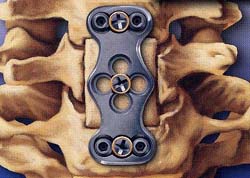
An anterior cervical plate (above) and fusion stabilizes the neck.
Many neck surgical procedures can be performed using minimally invasive techniques. Minimally invasive surgery uses smaller incisions and specialized instruments. Minimally invasive procedures benefit you in many ways such as smaller incisions, less time hospitalized, and a faster recovery.
Surgical Recovery
Most patients begin to get out of bed the same day surgery is performed. Activity is gradually increased and patients are typically discharged home within 1-2 days after their procedure, depending on the type and extent of the surgery. Some patients may even have this type of surgery as an outpatient in Colorado Comprehensive Spine Institute’s surgery center. As with most surgeries, expect some pain after the procedure. Pain medications help keep you comfortable.
At home, you need to continue to rest. You are given instructions how to safely and gradually increase activity. Pain medication may be needed for a while. However, pain and discomfort should begin to reduce within a week or two after surgery. Information about other ways to reduce pain and increase flexibility is provided, along with instructions about your return to work and other activities.
In addition treatment, our medical professionals have a deep commitment to patient education. By helping you understand the cause of your condition, we can help you eliminate risk factors and instill spine healthy habits for a lifetime. While you are under our care, our medical staff will provide you with excellent information to help you recover, minimize risk factors, and stay healthy.



